When it comes to protecting your vehicle, a dash cam can provide invaluable peace of mind. They capture the unexpected—accidents, parking lot mishaps, and even unwelcome scrapes while parked.
So naturally, investing in the right dash cam can feel like a no-brainer. But here’s the question: does the Vital Dash Cam measure up?
Today, I’ll break down the Vital Dash Cam’s features, performance, and why I wouldn’t wholeheartedly recommend it based on what users have shared.
Whether you’re already familiar with dash cams or considering one for the first time, this review should give you a clear picture of what to expect. Let’s weigh its pros and cons, explore some maintenance tips, compare it to other brands, and get to the bottom of whether Vital truly lives up to the hype.
My Experience With Vital Dash Cam
My experience with the Vital Dash Cam was a mixed bag. Setting it up was challenging due to the vague instructions; the manual was tiny, and I found myself piecing things together.

After sorting out the wiring, I was hopeful. The camera’s 1080P resolution captured daytime footage well enough, with clear views of the road and surroundings.
However, I noticed it struggled at night.
Despite the advertised “night vision,” the video quality wasn’t sharp in low light, making it hard to see details.
A big disappointment was the reliability.
Within two months, the dash cam started having trouble recognizing the SD card, and I’d often find it rebooting randomly. This wasn’t a one-off issue—many users seem to experience the same problems, pointing to quality concerns.
Additionally, the battery wouldn’t hold a charge for long, and I found myself dealing with this more than expected.
The parking monitor was one feature I hoped would provide some added protection while my car was parked. Unfortunately, because it required a constant power source, it didn’t always work unless I had it plugged in, which limited its convenience.
While it’s budget-friendly, I wouldn’t recommend the Vital Dash Cam if reliability and consistent performance are top priorities. I found myself wishing I had invested a bit more in a more dependable brand, especially given the importance of a dash cam in capturing crucial moments on the road.
In the end, this experience highlighted that sometimes, paying a little extra for quality is well worth it.
Pros And Cons of The Vital Dash Cam
While the spec sheet is impressive, real-world performance often tells a different story. Here’s what stands out based on user feedback:
Pros
- Wide Coverage: The wide-angle lens is effective, reducing blind spots and capturing a broader view, which is useful for both city and highway driving.
- Good Resolution in Ideal Conditions: The 1080P resolution does its job under good lighting. Daytime footage tends to come out fairly crisp and detailed.
- Emergency Lock Feature: The G-sensor works well enough, capturing and protecting footage after an impact, which can be vital for insurance claims.
Cons

- Lack of Durability: Many users report that the dash cam has a short lifespan. Issues range from battery failure to SD card compatibility problems after just a few months. Constant rebooting and unresponsiveness have also been flagged as frequent concerns.
- Confusing Setup and Instructions: Vital Dash Cam’s manual and setup instructions are reportedly frustrating to read and understand. The poor-quality manual, combined with vague installation directions, has left users guessing at how to properly mount and wire the device.
- Missing Accessories: Several customers were disappointed to find missing parts, especially memory cards, upon purchase. Adding to their frustration, the device was ineligible for returns due to missing components.
- Unreliable Customer Support: Many users feel stranded without a proper support system. A few have voiced frustration over return issues, with strict policies making it hard to return defective units.
- Night Vision Quality Falls Short: Despite promising night vision and WDR technology, the Vital Dash Cam struggles in low-light conditions, often failing to capture clear footage at night.
Maintenance Tips For Prolonging the Life of Your Dash Cam
Owning a dash cam involves some maintenance to keep it working optimally. Here are a few pointers if you already own or still plan to try out the Vital Dash Cam:
- Regularly Format Your SD Card: Periodically formatting the SD card can prevent compatibility issues and keep your dash cam running smoothly. Aim to format it once a month.
- Check for Firmware Updates: Updates can help fix bugs, enhance performance, and occasionally add new features. Check the manufacturer’s website for any available updates.
- Avoid Excessive Heat Exposure: Prolonged exposure to high temperatures can damage the battery and internal components. Park in shaded areas when possible.
- Inspect Wiring and Connections: Loose wires can interfere with recording. Occasionally check to ensure everything is connected securely, especially if the camera seems to reboot frequently.
- Handle with Care: The Vital Dash Cam seems particularly sensitive to rough handling. Be cautious when adjusting or removing it from the windshield mount.
Comparing Vital Dash Cam To Other Brands
When looking at alternatives, a few reliable dash cam brands come to mind. Let’s see how the Vital Dash Cam stacks up against popular choices like Garmin, Nextbase, and VIOFO.
- Garmin Dash Cam Mini 2
Garmin’s Mini 2 is a compact, straightforward dash cam with 1080P recording and a decent night vision mode. While it’s slightly more expensive than the Vital Dash Cam, the Garmin Mini 2 is known for its durability, excellent video quality, and ease of use.
Where Vital fails in reliability, Garmin excels. Additionally, Garmin offers clear installation instructions and robust customer support.
- Nextbase 522GW
The Nextbase 522GW is a premium option with excellent 1440P resolution, GPS, Alexa integration, and emergency SOS. It’s definitely pricier, but you’re getting value with features that Vital lacks. It’s ideal for those seeking high-quality footage and advanced features like emergency response.
Where Vital offers the basics, Nextbase adds sophistication and quality—especially in terms of night performance.
- VIOFO A119 V3
VIOFO’s A119 V3 offers solid 1440P resolution and a great Sony STARVIS sensor for low-light performance, making it a popular mid-range choice.
Unlike Vital, which has persistent durability concerns, the VIOFO A119 V3 is built to last with a heat-resistant design. If night clarity and dependability are priorities, VIOFO easily outshines the Vital Dash Cam.
Each of these alternatives not only provides better long-term reliability but also comes with better user support. While Vital may appeal to budget-conscious buyers, the limited support and reliability issues might end up costing you more in the long run.
Also Read: Is ROVE Dash Cam Worth It?
Frequently Asked Questions (FAQs)
Dash cams, while useful, do have some drawbacks. Battery-dependent dash cams like the Vital can drain quickly, especially if used with parking monitor features. Additionally, some dash cams may have limited storage or require periodic maintenance, like SD card formatting, which can be tedious for some users. And, of course, there’s the matter of installation complexity, particularly if the device lacks user-friendly instructions.
The Vital Dash Cam starts recording as soon as it’s powered on, recording video footage to an SD card in continuous loops. The G-sensor activates during sudden impacts, locking and saving video segments to prevent accidental deletion. Additionally, motion detection and parking monitor features capture any activity near your vehicle even when parked (assuming it’s connected to a power source).
While some insurance providers offer discounts for dash cam use, it’s not a universal policy. Dash cams can potentially help in claims by providing video evidence during incidents, which could indirectly reduce premiums in the long run. However, you’ll want to check with your provider to see if they recognize dash cams for any premium reduction.
Yes, but only if they have a dedicated power source. Vital’s parking monitor feature allows it to record when the car is off by detecting motion around the vehicle. However, for this feature to work, the camera needs continuous power, typically through hardwiring or an external battery pack.
Final Verdict: Is the Vital Dash Cam Worth It?
In short, the Vital Dash Cam may seem like a budget-friendly option, but its performance doesn’t quite measure up. While it boasts some attractive features—like 1080P recording, wide-angle coverage, and basic night vision—the shortcomings are hard to ignore.
Users consistently report reliability issues, missing accessories, and subpar night footage. And without strong customer support to back up the product, it’s hard to justify the purchase when there are better, more reliable options available.
If you’re serious about investing in a dash cam that will last, it might be worth considering alternatives from Garmin, Nextbase, or VIOFO. While they may come with a slightly higher price tag, the quality and reliability you’re getting in return make it a worthy investment for your peace of mind.
So, while the Vital Dash Cam brings some baseline features to the table, it doesn’t quite deliver the reliable performance most of us look for in a dash cam.


The dash cam sucks. I bought it along with a 3 year warranty for $85. They were only able to refund me for $15 with restocking fees. The camera is of poor quality and manual / instructions are non-existent. I Would never buy from them again.
Don’t waste your money on the 1080 Dash Cam. Without car power the battery lasts less than a minute. So you must string a wire from your cigarette lighter to the camera on the windshield. Even when you use the car’s power, when you park and shut the engine down, the cigarette lighter power shuts off too and the parking feature is useless. Also, not only do you pay for return shipping but also a 15% restocking fee. Don’t waste your money.